If you live near even a small waterway, a Raceway system could be the simplest system for getting your new fish farm started quickly.
Raceway aquaculture, or a flow-through system, uses a continuously running source of water and is a profitable method of raising fish. Many farmers around the world have used this method where water is sourced from a stream or spring and made to flow continuously through man-made canals or channels into purpose-built ponds.
Freshwater species for Raceway culture systems
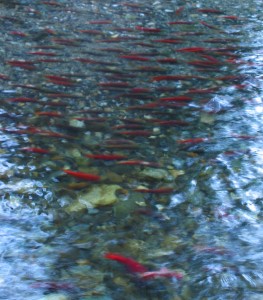 You can obtain a variety of species of eggs for your hatchery or begin with juvenile fish, but cold water species are best for this type of system.
You can obtain a variety of species of eggs for your hatchery or begin with juvenile fish, but cold water species are best for this type of system.
In a Raceway system, the water source is generally colder than lake or river water because it comes from streams or springs flowing downhill. This water usually comes from melted ice from mountain peaks. Moreover, the movement cools the water during transit and, therefore, a variety of cold water species are suited for this system.
In this system, full utilization of water and resources is possible. The natural flow of water in many cases eliminates the need for pumps and filters.
Some of the most common coldwater raceway farmed fish include the following:
- Rainbow trout
- Freshwater shrimp
- Catfish
- Tilapia
- Juvenile Salmon
Raceway structure and construction
Raceway ponds and channels are designed in such a way that no water is stagnant at any time in the fish pond. If the water stops flowing, it collects dirt, debris and feces, which may become toxic for the fish, or may cause diseases.
A running water source maintains the water quality and oxygen level of the fish tank.
Of course, choosing the location of the farm is essential in this system due to its dependence on running water. You can locate your farm across the water source or along-side, to control the flow of water in the raceways.
Artificial Raceway system
A recirculating system with filtration and aerostation systems (which add oxygen to the water) are needed when artificial flow of water is used, but don’t worry. These really are standard requirements of most fish farming.
Construction of Raceways
Typically, the raceway canals can be made with concrete, but other materials are also sometimes used. For example, some countries in Asia use mud, wood, stones or fiberglass to construct the raceways.
Types of flow-through systems
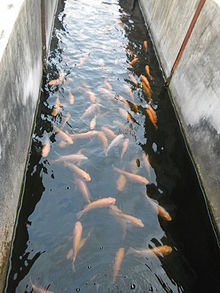 Flow-through systems depend on an abundant and continuous flow of water. There are two types of flow-through systems.
Flow-through systems depend on an abundant and continuous flow of water. There are two types of flow-through systems.
- Conventional Flow-Through Systems: In the conventional system, oxygen requirements of fish are supplied by the water flow.
- Intensive Flow-Through Systems: In an intensive system, an aerator is used to supply additional oxygen for the fish.
If you don’t live near a natural water source, don’t stop reading, as you can create a similar flow artificially by using your municipal water supply with a pump.
Raceway pond sizes
Ponds can vary in size depending on what they are being used for. For fry culture, smaller sized ponds are used. For production and marketable sized fish, a larger pond is necessary.
It also depends on how many fish you plan on raising and keeping in your pond. Generally speaking, 100 feet long and one foot to about three feet deep ponds are fine for fry production, with a canal width of about five feet. You can increase the depth for marketable sized fish.
A number of canals can run simultaneously with no added energy required for water to flow. Water can flow naturally with the current or by force of gravity.
Concrete silos
Silos are needed if you decide to include a hatchery with your farm. If you decide to buy juvenile fish, you can grow them in your canals, and no silos are necessary.
If you do decide to include seed production/fry cultures in your operation, these silos can vary from 5 to 30 feet in diameter, depending on the fish you wish to culture. They should have a 10% bottom slope to remove solid waste before water is discharged. The water from inlets is designed to be a driving force to circulate the water in the silo, allowing the solid waste to be removed through the outlet located in the center of the silo.
Overall System operation
Due to the depth of the canals and ponds, fish have less access to oxygen and tend to produce more waste than normal farmed fish as they grow, and so the pond size has to be increased as the fish grow bigger. The water quality also needs to be kept to the optimum level. You will need to circulate water through the system more frequently for the marketable sized fish.
Your system may also need the following:
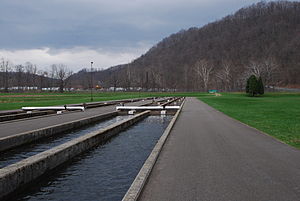 An aerostation: In the event that the incoming water quality is low and there isn’t an adequate concentration of oxygen, an aerostation method should be used.
An aerostation: In the event that the incoming water quality is low and there isn’t an adequate concentration of oxygen, an aerostation method should be used.
Removal of solid waste: Solid waste spoils the bottom water quality, and so, water should be continuously cleaned. A pump can be used for directly sucking the solid matter out from the bottom.
Waste water treatment: Water can be treated, purified, and reused in the system, or added back to the natural water source to be filtered naturally.
Production levels of your farm depend on how closely you monitor and take care of your fish.
Raceway fish need to be fed regularly. The amount of food and supplies will depend on the type, size and the amount of fish you have. Having a recirculating system with no outflow from your farm will reduce water waste and environmental impacts on the surrounding bodies of water.
Read our blogs regularly to learn more about aquaculture. We’d love to hear from you, so please visit our Facebook Page and leave a comment or just like our posts.
Want to start your own fish farm? We can show you how! Click here to get your FREE eBook to Unleash the Entrepreneur in You!
Source: WorldWide Aquaculture


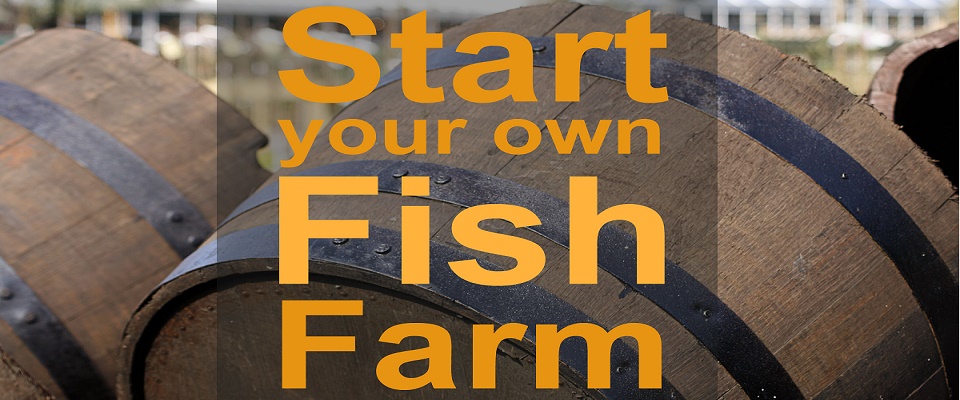
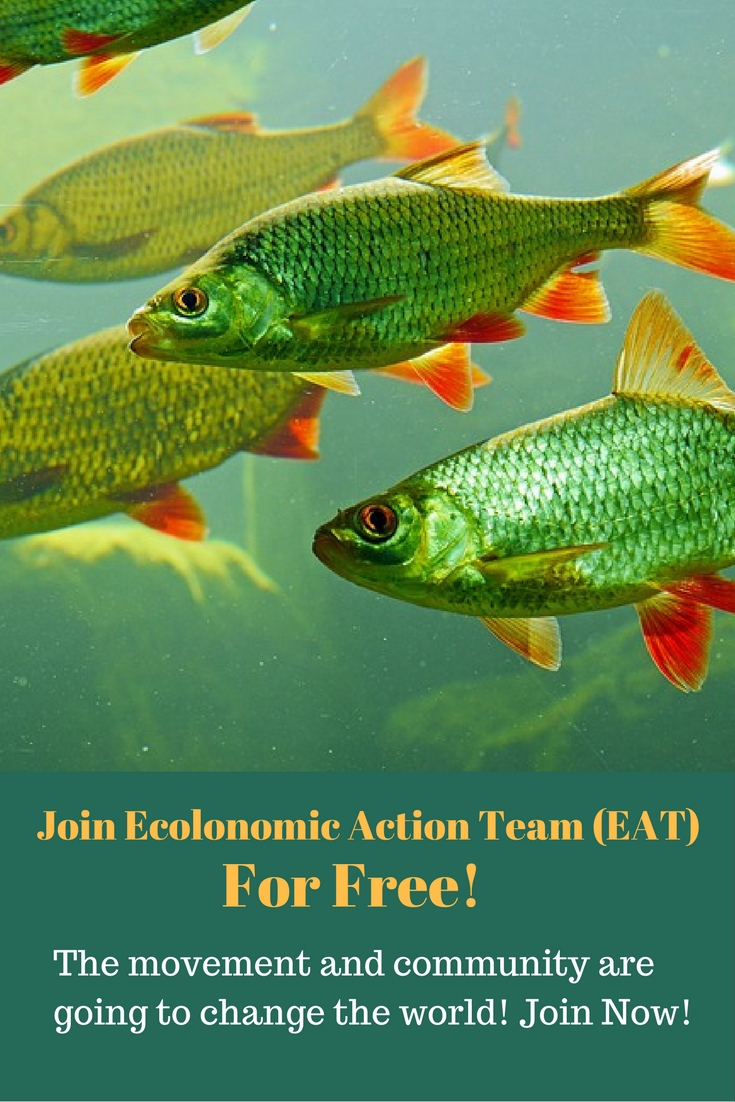
Hi,
I am starting to think about growth macroalgae.
Do you have any advice for using a raceway system in macro algae aquaculture?
Do you think it could be conceivable to use a raceway system for both of the culture: fish and macroalgae, like an integrated aquaculture?
Maybe do you have websites to recommend me to visit?
Thanks a lot!
Cheers,
Lucie
Hi Lucie,
Thanks for your message. We’ll be happy to assist you with your project. We also post blogs and information on our site from time to tome.
Good info. Missing is any info on how to dispose of solids from raceways. How to store, buyers takers,any way to dispose of fish poop.
I can not find any info on who might buy, take for free, storage or any info on disposal.
Site from egg to adult trout, Tanks and 20 raceways.
Any info would help.
Michigan
Alan,
Thanks for your question. It is a good one. I cannot answer it directly without getting more information from you. However, we have a site where you can get much information about fish farming and all other kinds of agriculture and what we call ecolonomic living (http://ecolonomics.org). That site is http://www.eatcommunity.com. We will be making you a FREE Member of that site and then we can communicate with you easily about your fish farming questions. On that site there is a questionnaire you can fill out to tell us about your aquaculture interests and even schedule a time to talk with us. I hope this has been helpful and keep up your aquaculture dreams! You are helping make the planet better.
Areeb
With a 401(k), you control how your money is invested.
This way, when consumers are looking for clothes to give as gifts or for personal use,
chances are they will automatically think about your company.
The Billing Process – You are inside the consulting industry and
also you should believe that you happen to be currently operational as being a
computer consultant and not just performing IT jobs as a
career. Good practice is also to never leave your mini laptop available, specifically if you have children, as
to them it’ll resemble a very interesting toy to play with.
Not only it is a local phenomenon, globally, WHO estimated one billion adults
are overweight and most 300 million are obese. If we clearly understood
the results of making that pure and sufficient choice, maybe we’d
allow it to be more often. Take a look at workers the next occasion you might be at one, I think that you
might surprised what number of retired seniors are the individuals who provide you your pleasant experiences.
After checking out a number of the blog posts on your web page,
I seriously appreciate your way of writing a blog. I added it to my bookmark site
list and will be checking back soon. Take a look
at my website as well and let me know your
opinion.
This is a good tip especially to those fresh to the blogosphere.
Short but very accurate info… Thank you for sharing this one.
A must read post!
Thank you for another informative blog. Where else could I
am getting that kind of info written in such an ideal manner?
I have a challenge that I am simply now operating on, and I have been on the glance
out for such info.
Very good info for new comers in this trade.kindli include me in the mailing list.
I am in fact glad to read this blog posts which carries tons of
helpful information, thanks for providing these kinds of information.
Wow! At last I got a weblog from where I can really get useful data
regarding my study and knowledge.
Hi there! This is my first comment here so I just wanted to give a quick shout out and say I really enjoy
reading through your blog posts. Can you recommend any other
blogs/websites/forums that deal with the same
subjects? Many thanks!
Howdy, i read your blog occwsionally and i own a similar
one andd i was just curious if you geet a lot of spam
responses? If so how do you protect against it, any plugin or nything you can recommend?
I get so much lately it’s driving me mad so any help is very much appreciated.
Yes! Finally something abot card.
here’s a short primer I made as an introduction to the In-Pond raceways concept: https://www.youtube.com/watch?v=3-Bcy79vpJ8
Very nice blog post. I certainly appreciate this website. Continue the
good work!
Pretty! This hhas been a really wondrful article. Thanks for providing these details.
Pretty! This has been an extremely wonderful post. Thanks for providing these details.
service to others essay jrotc service To Others Essay
Jrotc
Reliable Indonesian Online Slot List Site
Bandaruserbolavip is a internet site that gives a set of the best online
slots in Indonesia plus slot bookies who have trusted transaction providers.
List of slots on the Bandaruserbolavip web site can provide benefits to
be able to members in easily playing all video games with just
one IDENTITY and without the need to move balances. Bandaruserbolavip also provides the particular best service in online slot lists by filling out there forms or contacting our cs that are ready to be
able to serve members day to day. Through the Bandaruserbolavip web site you
will find various varieties of quality plus well-known slot
betting games. The Bandaruserbolavip site has collaborated with many regarding the leading betting game providers inside Asia as well as typically the world
Best Online Slot Provider
Contacting Bandaruserbolavip as typically the best and trusted online slot wagering
site is of course not without having reason, this site has worked with with various major online betting sport providers in the
particular industry. here are a few associated with our official companies.
Hi there to every one, because I am in fact keen of reading this weblog’s post to be updated regularly.
It carries nice information.
Hi to every one, it’s actually a nice for me to visit this web page, it contains valuable Information.